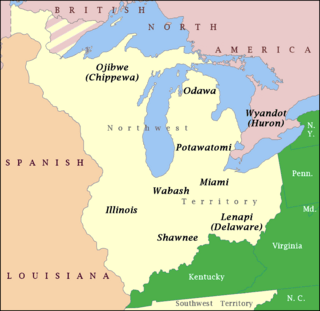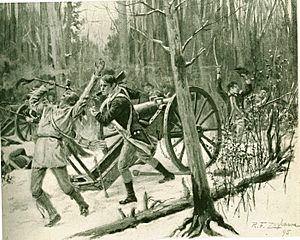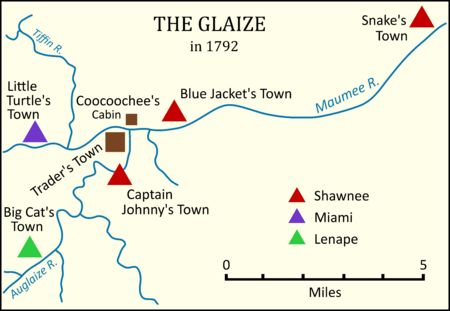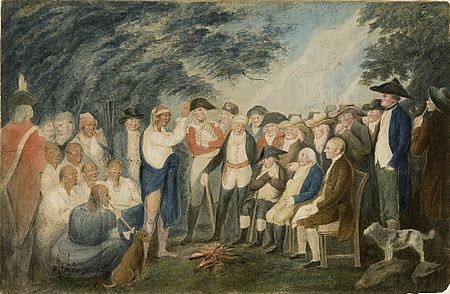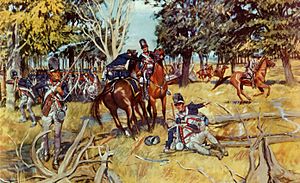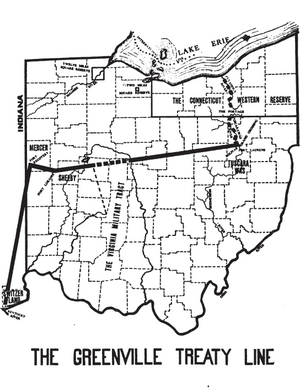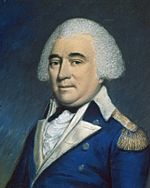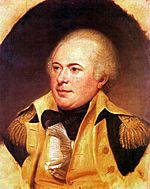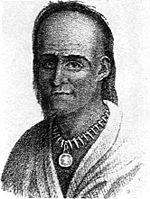Northwest Indian War facts for kids
Quick facts for kids Northwest Indian War |
|||||||||
|---|---|---|---|---|---|---|---|---|---|
| Part of the American Indian Wars | |||||||||
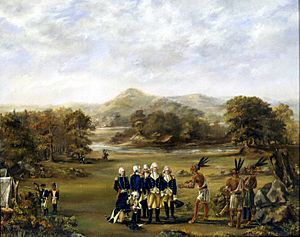 This depiction of the Treaty of Greenville negotiations may have been painted by one of Anthony Wayne's officers. |
|||||||||
|
|||||||||
| Belligerents | |||||||||
Chickasaw Choctaw |
|
||||||||
| Commanders and leaders | |||||||||
| Blue Jacket Little Turtle Buckongahelas Egushawa |
|||||||||
| Casualties and losses | |||||||||
| 1,221 killed 458 wounded |
1,000+ killed Unknown wounded |
||||||||
The Northwest Indian War (1786–1795) was a conflict for control of the Northwest Territory. This area is now part of the United States. The war was fought between the United States and a group of Native American nations. This group is known today as the Northwestern Confederacy. The United States Army sees this as the first of the American Indian Wars.
After many years of fighting for this land, it was given to the new United States. This happened in the Treaty of Paris in 1783. This treaty ended the American Revolutionary War. The treaty set the Great Lakes as the border between British land and the United States. This gave a lot of land to the United States. This land was known as the Ohio Country and the Illinois Country.
However, many Native American peoples lived in this area. The British also kept soldiers there. They continued to support their Native allies. As American settlers moved west of the Appalachian Mountains, Native groups formed a confederacy in 1785. They wanted to stop settlers from taking their land. They declared that lands north and west of the Ohio River were Native territory.
Four years after the conflict began, George Washington became the first president. He was also the commander of the U.S. military. Washington ordered the United States Army to take control of the territory. The U.S. Army was mostly made of new recruits and volunteers. They suffered big defeats. These included the Harmar campaign (1790) and St. Clair's defeat (1791). These were some of the worst defeats in the history of the U.S. Army.
St. Clair's loss destroyed most of the U.S. Army. This left the United States vulnerable. Washington quickly needed to build a bigger army. He chose General Anthony Wayne, a veteran of the Revolutionary War. Wayne was to organize and train a new fighting force. Wayne took command of the new Legion of the United States in late 1792. He spent a year training his troops and getting supplies.
Wayne led his Legion to a big victory at the Battle of Fallen Timbers in 1794. This battle was near Lake Erie (close to modern Toledo, Ohio). After this, he built Fort Wayne at Kekionga. This was the Miami capital. It showed U.S. control in the heart of Native land. The defeated tribes had to give up a lot of land. This included much of present-day Ohio. This was part of the Treaty of Greenville in 1795. The Jay Treaty in the same year made the British leave their forts in U.S. territory. The British would briefly retake this land during the War of 1812.
Contents
Why the War Started: Background
In the French and Indian War (1754–1760), France and Great Britain fought for control of the Ohio and Illinois countries. These were lands south of the Great Lakes. Native tribes in the region fought on both sides. They chose the side that best met their needs. In 1763, France gave the region to the British.
That same year, Native groups started Pontiac's War. They wanted to push the British away. To avoid more fighting, the British made the Royal Proclamation of 1763. This created a border between colonists and Native lands.
In 1768, British officials made the Treaty of Fort Stanwix with the Iroquois. The Iroquois claimed control over the Ohio Country. This treaty moved the border further west. It opened up land south of the Ohio River for settlers. Many immigrants began moving into the region.
However, Native groups like the Shawnee and Cherokee used Kentucky for hunting. They were not asked about the treaty. They said the Iroquois had no right to sell the land. In the early 1770s, the Shawnees tried to form a new Native confederacy. They wanted to stop settlers. But British officials used the Iroquois to isolate them. The Shawnees fought and lost Lord Dunmore's War in 1774. They had to agree to the Ohio River as the border.
To control the frontier better, the British Parliament passed the Quebec Act in 1774. This put the whole region under the control of Quebec. This angered American colonists who wanted to settle these lands. This helped lead to their decision to declare independence in 1776. Many Natives joined the British in the western part of the American Revolutionary War. They hoped to drive out American settlers.
In the 1783 Treaty of Paris, Great Britain gave the region to the United States. It did not mention Native land rights. Mohawk leader Joseph Brant was surprised. He said "England had sold the Indians to Congress." In 1783, he helped form the Northwestern Confederacy. This was a large group of tribes working together.
At a meeting in Junquindundeh (modern Fremont, Ohio), Brant argued that Native lands belonged to all tribes. No land could be given away without everyone agreeing. Leaders from the Iroquois, Shawnees, Delawares, Wyandots, and others attended.
The U.S. government needed money after the Revolution. They planned to sell lands north of the Ohio River to settlers. American officials did not recognize the Native confederacy. They said Native lands were taken by right of conquest. They tried to confirm this in treaties. Some Native leaders gave in and gave up land. This happened at Fort Stanwix (1784), Fort McIntosh (1785), and Fort Finney (1786). But many Natives wanted to defend their lands north of the Ohio River. Shawnees and Delawares called for war.
The War Begins: Early Actions
After some small fights along the Ohio River, the Kentucky militia launched a big attack in 1786. Generals George Rogers Clark and Benjamin Logan led two groups into Native land. Clark's group had problems and turned back. Logan's group of 790 men went to Shawnee towns. They burned the towns and food supplies. They killed and captured many Natives. An elderly Shawnee chief named Moluntha was killed.
After their towns were destroyed, Shawnee people moved to live with the Miamis. They settled near Kekionga, the Miami capital. This area became home to many strong members of the Northwestern Confederacy. The confederacy met again. On December 18, 1786, they called themselves the "United Indian Nations." They sent a letter to the U.S. Confederation Congress. They said the recent treaties were not valid. They asked for a new treaty meeting in 1787. They suggested that both sides stay on their own side of the Ohio River until then.
In July 1787, the U.S. Congress created the Northwest Territory. This was north of the Ohio River. It was for American settlement. Arthur St. Clair was made governor. He was told to make new treaties. He was not to give up any land already taken. He was also to try and get more land. He was to weaken the Native confederacy.
In 1788, St. Clair invited Natives to Fort Harmar. This was near Marietta, an American settlement. Brant asked if St. Clair would accept a new border. This border would keep everything west of the Muskingum River as Native land. St. Clair said no. Brant then refused to join the talks. The Northwestern Confederacy was divided. Those closer to Americans wanted to compromise. Those further away, like the Miamis, wanted the Ohio River as the border.
In January 1789, some Native chiefs signed the Treaty of Fort Harmar. This treaty just confirmed the old, disputed treaties. St. Clair thought the confederacy was broken. But instead, he made Natives who wanted peace lose trust. This made the strong fighters more powerful.
After the Fort Harmar treaty, violence grew. Natives attacked boats on the Ohio River. They raided Kentucky, killing settlers. They wanted to stop new people from coming. Americans fought back. In 1790, George Washington, the first president, and Secretary of War Henry Knox decided to attack the Native confederacy. They wanted to secure the Northwest Territory for Americans.
Congress kept the United States Army small. They used state militias for defense. In 1790, Congress made the army's only regiment, the First American Regiment, larger. Americans would use both militia and regular soldiers. A U.S. Army officer would be in charge.
1790: Harmar's Campaign
In April 1790, the First American Regiment attacked a Shawnee village. General Josiah Harmar led this attack with Kentucky General Charles Scott. The next month, Natives attacked settlers near Limestone, Kentucky. Five settlers died.
That autumn, the United States launched a big attack. It was against the Natives along the Maumee River. General Harmar led this mission. His orders were to destroy Kekionga and nearby towns. He was to kill any Natives who fought him. His army had 1,100 militia and 320 regular soldiers. They left Fort Washington on September 30.
Native scouts watched Harmar's slow march. The Natives had scattered for their winter hunt. But Blue Jacket, the main Shawnee war chief, and Little Turtle, his Miami counterpart, called warriors to gather. They got about 600 men to fight Harmar's army. This was not enough men. So, they moved their families out of the towns on October 14. They waited for a chance to strike.
Harmar's first group reached Kekionga on October 15. They spent days looting and burning Native towns. They also destroyed crops. On October 19, a group of Harmar's men were ambushed. About 150 Shawnee and Potawatomi warriors defeated them. Soon after, more Native warriors joined them.
On October 21, Harmar said his goal was met. The towns were destroyed. The army would return to Fort Washington. The expedition had destroyed five Miami towns and much of their corn. They marched south. But the next day, Harmar let 400 men go back to Kekionga. They were to attack any Natives who came back. Natives ambushed them again and defeated them. The survivors barely made it back to Harmar's army.
Blue Jacket and Little Turtle wanted to attack Harmar's retreating army. But a lunar eclipse that night was seen as a bad sign. The attack was called off. Harmar's expedition ended in defeat. 183 Americans were killed or missing. The Miamis lost many warriors. Harmar's military career was over. His campaign was seen as a "national embarrassment."
1791: St. Clair's Terrible Defeat
After Harmar's defeat, Natives rebuilt their villages. Some moved to new places. Natives usually did not fight in winter. But they attacked American settlements north of the Ohio River. On January 2, 1791, Wyandots and Delawares attacked Big Bottom. They killed eleven settlers. Soon after, Shawnees and Wyandots led by Blue Jacket attacked Dunlap's Station. They left a war club, a sign of war. These attacks showed that American settlement could not continue until the Natives were defeated.
In response to Harmar's defeat, Congress made the U.S. Army bigger in March 1791. Washington made Arthur St. Clair, governor of the Northwest Territory, a major general. St. Clair was ordered to lead another attack to the Maumee River. He was to build a fort there to control the Natives.
In May 1791, St. Clair sent Brigadier General Charles Scott on a raid. Scott had 750 mounted Kentucky militia. Natives gathered nearly 2,000 warriors at Kekionga. They expected to fight Scott. But Scott went northwest instead. He attacked undefended Wea towns on the Wabash River. He destroyed Ouiatenon and Kethtippecanunk.
St. Clair wanted to start his main campaign in July. But he was sick and lacked new soldiers. In August, he sent Lieutenant Colonel James Wilkinson on a second raid. Wilkinson had 500 mounted Kentucky militia. He destroyed a Miami town on the Eel River.
In September, St. Clair's men built a supply base, Fort Hamilton. This was north of Fort Washington. The army finally left Fort Hamilton on October 4 with about 2,300 men. In mid-October, they built a second base, Fort Jefferson. As they marched slowly toward Kekionga, they had problems. They ran out of food. Morale was low. Many soldiers left. On October 31, St. Clair sent 300 of his best troops back. This left him with about 1,400 people.
On November 3, St. Clair's army camped near modern-day Fort Recovery, Ohio. Just before dawn on November 4, Native forces attacked. More than 1,000 warriors were led by Little Turtle and Blue Jacket. They launched a surprise attack. They first attacked the militia, who ran away. This caused confusion in the American camp. The Americans were surrounded. They tried to fight back. Natives fired from cover, targeting officers. After three hours, St. Clair ordered a retreat. They left many wounded and most of their equipment. Major General Richard Butler, St. Clair's second-in-command, was killed. Most Americans fled all the way back to Fort Washington.
This battle was a huge victory for the Natives. The Americans lost 630 soldiers killed and about 250 wounded. About 30 civilians, mostly women, were also killed. Native losses were small: 21 killed and 40 wounded. Historian Colin Calloway said it was "the biggest victory Native Americans ever won." It was also "proportionately the biggest military disaster the United States ever suffered."
The Natives, short on food, went hunting for winter. Little Turtle and Blue Jacket decided to leave Kekionga. It was too easy for Americans to attack. They moved their towns to where the Maumee and Auglaize Rivers meet. This area was called "The Glaize." It became the main base for the Native confederacy.
1792: Building a New Army
After St. Clair's defeat, the U.S. Congress investigated the disaster. St. Clair stayed as governor but had to leave his military job. President Washington asked Congress to raise an army strong enough to defeat the Northwestern Confederacy. In March 1792, Congress passed a law to make the army bigger. It would have over 5,000 men. Major General "Mad" Anthony Wayne was chosen as the new commander.
While the American army was getting ready, Washington and Knox tried diplomacy. They wanted to buy time and calm Americans who opposed the war. In March 1792, Iroquois leaders met with U.S. officials. They were asked to attend a Native confederacy meeting. They were to present U.S. peace terms. The U.S. also tried to talk directly to the Northwestern Confederacy. This was hard because Americans still held forts north of the Ohio River. In March 1792, Wilkinson built Fort St. Clair. This helped connect Forts Hamilton and Jefferson. The next month, Knox sent messengers to the Natives. They were both killed. In June, about 50 warriors attacked Fort Jefferson. They killed and captured fifteen soldiers.
Rufus Putnam was a brigadier general. He was told to make a truce with the Northwestern Confederacy. He went to Vincennes instead. In September 1792, he made a treaty with tribes on the lower Wabash River. Knox thought this weakened the confederacy. But the U.S. Senate rejected the treaty. It did not say that only the United States could buy Native lands.
In late September 1792, the Natives held a large meeting at the Glaize. Many tribes were there. Iroquois delegates, including Red Jacket, came. They presented the U.S. peace offer. Red Jacket suggested the Muskingum River as the border. The Shawnee speaker Red Pole spoke for the confederacy. Red Pole said the Iroquois should not talk about giving up more land. He said, "We do not want compensation" from Americans. "We want restitution of our country." After much debate, the council agreed with Red Pole. The Ohio River was the only acceptable border. American forts north of the river must be destroyed. The council also agreed to meet with Americans in 1793.
When Red Jacket told an American official about the meeting, he left out the demands about the Ohio River border and destroying forts. So, Americans thought the confederacy would accept their terms. Knox agreed to send treaty commissioners in 1793. He also stopped all attacks until then. This angered General Wayne.
After the Glaize meeting, Red Pole traveled south. He tried to get more Chickamauga Cherokees and Creeks to join the confederacy. This was not successful. Meanwhile, on November 6, Little Turtle and about 200 Miamis and Shawnees attacked a supply convoy. It was near Fort St. Clair. They killed six Americans. They took the packhorses needed to supply the forts.
1793: Peace Talks Fail
While General Wayne waited for peace talks, he trained his army. This army was called the Legion of the United States. They trained at Legionville near Pittsburgh. Wayne believed past expeditions failed because of poor discipline. He trained his troops very well. By May 5, 1793, the Legion moved to a camp near Fort Washington. Wayne waited for orders to begin his invasion.
In mid-May, U.S. commissioners arrived at Fort Niagara. They were Benjamin Lincoln, Beverley Randolph, and Timothy Pickering. They traveled by the Great Lakes to avoid danger. Niagara was a fort still held by the British. John Graves Simcoe, the British lieutenant governor of Upper Canada, hosted them. Simcoe had been trying to reduce U.S. influence among Natives. He hoped Britain would support a Native buffer state. This state would be between the U.S. and Canada.
At Niagara, a Native group led by Brant visited the commissioners. Brant asked if the commissioners could make a new border. He also asked why Wayne's army was preparing for war. The commissioners said they could negotiate a border. They said fighting had stopped. Brant returned to the Maumee and reported to the confederacy. He was criticized for not insisting on the Ohio River border. A new group was sent to meet the commissioners.
This second meeting was held on July 30. It was at British Indian agent Matthew Elliot's home. The Wyandot chief Carry-One-About spoke for the confederacy. Buckongahelas (Delaware) and Kekewepelethy were there. The confederacy gave its final demand. The Ohio River was the only acceptable border. Forts and settlers north of the river must be removed. The commissioners said lands north of the Ohio had already been sold and settled. They could not be returned.
The Native delegates went back to the Maumee to talk. Brant argued for compromise again. But the strong fighters, supported by Alexander McKee, won. On August 13, the confederacy sent a written statement. It was signed by all nations except the Iroquois. This document showed their pride and independence. They offered a solution. The U.S. should pay settlers to move south of the Ohio River. This was unacceptable to the Americans. The commissioners said, "the negotiation is therefore at an end."
When talks failed, Wayne advanced. He reached Fort Jefferson on October 13 with 2,600 men. On October 17, an Odawa war party attacked a supply convoy. They killed fifteen and captured ten. Wayne had to use more troops to guard his supplies. Wayne decided to stop major operations. He built Fort Greenville north of Fort Jefferson. The Natives also had problems. Many warriors went hunting for winter. The Legion stayed at Fort Greenville for the winter. On December 23, Wayne led about 300 men to the site of St. Clair's defeat. His troops built Fort Recovery. They buried the American dead and got back three cannons lost in 1791.
1794: Decisive Battles

In January 1794, the confederacy sent a group to Fort Greenville. They wanted to free two Delaware women. A Delaware chief asked if Wayne would talk peace. Wayne said he would only talk if Natives stopped fighting. They also had to release all American prisoners in thirty days. The strong Native leaders at the Glaize debated this. They were surprised talks started without their permission. The strong leaders won, and the idea was dropped.
In February 1794, Lord Dorchester told an Iroquois group that Britain might go to war with the U.S. soon. He said Native lands lost to Americans would be returned. Dorchester ordered Simcoe to build a fort on the Maumee. This was to defend Detroit from Americans. In April, Simcoe built Fort Miami. He put 120 soldiers there. Dorchester's words and actions angered the United States. Building Fort Miami on U.S. land was seen as an act of war. In May, Chief Justice John Jay was sent to England. He was to solve the problem. The Native confederacy was encouraged by British actions. They sent messages to get more warriors.
Battle of Fort Recovery
At Fort Greenville, Wayne had supply problems. But the building of Fort Miami made him speed up. He waited for more Kentucky militia. In late June, Wayne was joined by about 100 Chickasaws and Choctaws. They came from the south to fight their old enemies. On June 27, forty-five Choctaws and ten scouts fought a large group of Natives. The scouts were led by William Wells. Wells told Wayne that Fort Recovery was in danger.
The Native army marching toward Fort Recovery had 1,200 warriors. This was the largest force the confederacy had ever gathered. Natives did not have one overall commander. Decisions were made by a council of chiefs. Blue Jacket wanted to bypass the forts and attack American supply lines. But other leaders wanted to attack a convoy near Fort Recovery. They won the debate. On June 30, warriors ambushed the convoy. Then they rushed the fort. But American gunfire and cannons drove them off. The attack failed. Many warriors left and went home. This left Blue Jacket with about half his army. After the battle, Little Turtle and Tarhe (Wyandot) went to Detroit. They asked the British for help. But the British commander said he could not fight Americans without orders.
Battle of Fallen Timbers
On the morning of August 20, the Legion marched toward the Maumee River. This was near modern Toledo, Ohio. The confederacy had set an ambush there. The Legion had about 3,000 soldiers and militia. Many soldiers were defending supply trains and forts. Blue Jacket chose a battlefield where a tornado had knocked down many trees. This created a natural defense. He placed about 1,500 warriors there. These included Shawnees, Delawares, Miamis, Wyandots, and others. There was also a small group of Mohawks. A British company of Canadian militia, dressed as Native Americans, was also there.
Odawa and Potawatomi warriors attacked the Legion's scouts first. The Legion's front lines broke under the attack. Wayne immediately sent in his backup soldiers. He divided his infantry into two wings. The Legion's cavalry secured the right side along the Maumee River. General Scott's militia guarded the left side. Wayne ordered an immediate bayonet charge. Legion dragoons also charged with swords. Blue Jacket's warriors fled the battlefield. They tried to regroup at nearby Fort Miami. But the British garrison locked the fort doors. The British and Americans were becoming friends to fight France in Europe. The battle lasted little more than an hour. The Legion had 33 killed and 100 wounded. The confederacy had between 19 and 40 warriors killed. The battle caused distrust between Native nations and between the confederacy and the British. It was the last time the Northwestern Confederacy gathered a large army to fight the United States.
Wayne's army camped for three days near Fort Miami. British Major William Campbell commanded the fort. When Campbell asked why Wayne was there, Wayne said the sound of their guns and the Native retreat gave the answer. The next day, Wayne rode alone to Fort Miami. He slowly inspected the fort's outer walls. The British soldiers debated whether to attack Wayne. But they had no orders. They were already at war with France. So, Campbell did not fire the first shot. The Legion destroyed Native villages and crops near Fort Miami. They also burned Alexander McKee's trading post before leaving.
Wayne's Legion finally reached Kekionga on September 17, 1794. Wayne chose the site for a new U.S. fort. He wanted a strong fort. It had to withstand attacks from Natives and British forces. The fort was finished by October 17. It was named Fort Wayne. It was placed under the command of Hamtramck. The fort was officially opened on October 22. This was the fourth anniversary of Harmar's defeat. This day is considered the founding of modern Fort Wayne, Indiana. That winter, Wayne also built more forts. These included Fort St. Marys, Fort Loramie, and Fort Piqua.
Treaties of Peace: Greenville and Jay
Within months of Fallen Timbers, the United States and Great Britain made the Jay Treaty. This treaty required the British to leave their forts in the Great Lakes area. It also opened up some British territory for American trade. The treaty also allowed freedom of movement for Native Americans. This was for those living in lands controlled by the U.S. or Britain. The United States Senate approved the Jay Treaty in 1795. Wayne used this as proof that Britain would no longer support the confederacy.
The United States also made the Treaty of Greenville in 1795. This treaty forced the Native American tribes to give up southern and eastern Ohio. They also gave up land around forts and settlements in Illinois Country. They had to recognize the U.S. as the ruling power. They also had to give up ten chiefs as hostages. These hostages would stay until all American prisoners were returned. The Miami also lost control of the Kekionga portage. This was because Congress said important portages in the region must be free to use.
After the War: Changes and Legacy
Fort Lernoult and Fort Miami were left by the British in 1796. This was part of the Jay Treaty. U.S. forces under Colonel Hamtramck took over Fort Lernoult the next day. The U.S. renamed it Fort Detroit. Fort Miami was abandoned in 1799. The British later recaptured Fort Detroit and Fort Miami during the War of 1812. Fort Detroit was abandoned a year later. Fort Miami was abandoned in 1814 and later torn down.
Most of the western U.S. forts were also abandoned after 1796. Fort Washington was moved in 1804. It became the Newport Barracks. General Wayne oversaw the British leaving their posts. He chose the site for Fort Wayne to secure his Legion's victory.
Wayne died on December 15, 1796. This was one year after the Treaty of Greenville. Wayne's second in command, General Wilkinson, became the new commander. Wilkinson had tried to secretly undermine Wayne during the campaign.
After the war, many U.S. settlers moved to the Northwest Territory. Many made unfair land deals with Native nations. General Wilkinson had to cancel these deals in 1796. Five years after the Treaty of Greenville, Ohio became a separate territory. It followed the line of forts and the Greenville Treaty Line. The land west of that border was named Indiana Territory. In February 1803, Ohio became a state.
Future Native American resistance movements could not form a group as large or strong as the Northwestern Confederacy. Author Wiley Sword writes that the fate of Native Americans was decided in the wars of the 1790s. American historians of the 19th century often ignored this war. It did not fit their patriotic stories. So, the war never got a standard name or start date.
President Thomas Jefferson hoped to include Native Americans. He wanted them to adopt American ways. But he also encouraged taking their land. This was a way to weaken Native leaders. Territorial governor William Henry Harrison began taking Native land aggressively. Native Americans faced diseases, debts, and physical abuse from new settlers.
In 1805, Tenskwatawa started a traditional movement. It rejected United States practices. His followers settled at Prophetstown. This led to Tecumseh's War and fighting in the War of 1812. U.S. settlement continued. This led to more Native removals and conflicts. These included the Black Hawk War and the Potawatomi Trail of Death. Wisconsin, the last state fully in the Northwest Territory, became a state in 1848. Getting cheap land and selling it to white settlers helped pay off the United States' national debt.
Before he died, Little Turtle said, "More of us have died since the Treaty of Greenville than we lost by the years of war before." The United States' actions in the Northwest Territory led to a major loss of land and way of life for Native Americans. The goal of American officials was to open up these lands for white settlement.
Key Figures in the War
United States Leaders
- Henry Knox: First United States Secretary of War.
- Josiah Harmar: General who led the 1790 Harmar campaign.
- Arthur St. Clair: Governor of the Northwest Territory and general at St. Clair's defeat.
- Anthony Wayne: General who led the Legion of the United States to victory at Fallen Timbers.
- Charles Scott: General commanding the Kentucky militia.
- James Wilkinson: Officer who was Wayne's second in command.
Native American Leaders
- Little Turtle (Miami)
- Blue Jacket (Shawnee)
- Buckongahelas (Delaware)
- Roundhead (Wyandot)
- Egushawa (Odawa)
- Joseph Brant (Mohawk)
British Empire Leaders
- Sir Guy Carleton, Lord Dorchester: Commander-in-Chief of British North America.
- William Campbell: British Major in command of Fort Miamis.
- John Graves Simcoe: Lieutenant Governor of Upper Canada.
- Alexander McKee: British Indian agent.
Many people who fought in this war became famous later. These include William Henry Harrison, William Clark, Meriwether Lewis, and Tecumseh. William Wells, who fought on both sides, later died at the Battle of Fort Dearborn.
See also
- Cherokee–American wars, a similar war in the southern U.S.


